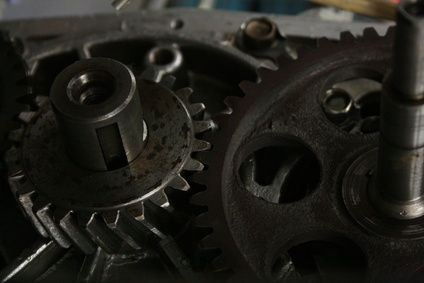
Routine maintenance on any vehicle prevents most difficult repairs. Parts wear down and require replacement throughout the years. One of the most expensive repairs is transmission work. The teeth on the gears wear down or crack. For most transmission work, the majority of the cost is the removal and installation of the transmission. Save money by removing the transmission yourself. Remember that transmission removal is not for the faint of heart or inexperienced.
Disconnect the negative cable from the battery. Unscrew the wing nuts or use a ratchet and socket to remove the cable.
Raise the vehicle with a jack until the tires are off the ground. Place jack stands underneath the suspension on the front of the vehicle. Place a wood block or brick behind the back tires to keep the vehicle from rolling off the stands.
Drain the transmission fluid. Place the jack under the transmission pan. Raise the transmission slightly. Place a drain pan under the transmission pan. Remove the front and side mounting bolts with a ratchet and socket. Loosen the back bolts 4 turns.
Pry the pan loose with a Phillips screwdriver. Lower the jack. Remove the remaining bolts with a ratchet and socket. Allow the fluid to drain. Drain the fluid from the pan.
Scrap traces of the gasket or sealant off of the pan with a putty knife. Clean the pan with solvent and dry the pan thoroughly with compressed air.
Remove the transmission filter by rotating the filter out of the retaining clip. Lower the filter from the transmission. Allow fluid to drain.
Remove the drain pan from underneath the vehicle.
Remove the 4 bolts on the torque converter cover with a ratchet and socket.
Remove the bolts connecting the driveplate to the torque converter using a ratchet and socket. Access each bolt by turning the crankshaft clockwise when viewed from the front.
Disconnect the 3 wires from the terminals on the starter motor. Use a wrench to remove the bolts. Remove the starter mounting bolts with a ratchet and socket. Remove the starter motor.
Remove the 4 bolts on the driveshaft with a wrench. Remove the nuts, washers and straps from the pinion flange on the driveshaft. Tape the bearing caps to the spider to keep the caps from coming off.
Lower the rear of the driveshaft. Slide the front of the driveshaft out of the transmission. Move the driveshaft out from under the vehicle.
Unplug the speed sensor. Unplug any wire harness connectors from the transmission. Remove any exhaust components that interfere with transmission removal.
Trace the cable from the throttle valve to the transmission. Remove the bolt and flat washer with a ratchet and socket.
Remove the shifter cable from the transmission. Pry the cable from the transmission oil pan clip with a Phillips screwdriver. Squeeze the cable retainer while pulling the cable toward the back of the vehicle and disconnect the cable.
Place the jack under the engine. Raise the jack to support the engine. Put a piece of wood under the oil pan to help distribute the weight.
Position a transmission jack under the transmission. Raise the jack to support the transmission.
Remove the rear transmission mount-to-crossmember nut with a ratchet and socket. The nut is located on the crossmember.
Remove the four crossmember-to-frame nuts with a ratchet and socket. Two nuts are located on each side of the frame.
Raise the transmission high enough to allow for removal of the crossmember. Remove the crossmember.
Remove the transmission bellhousing-to-engine bolts. The upper right bolt holds the dipstick tube in place.
Lower the transmission slightly and disconnect and plug the transmission cooler lines. Grasp the plastic cap and pull the cap out of the fitting to disconnect the lines. Slide the plastic cap about 2 inches back over the cooler line.
Pull out on one of the open ends of the retaining clip using a small hooked tool. Rotate the clip out of the fitting. Completely remove the clip.
Pull the cooler line straight out of the fitting. Remove the transmission dipstick tube.
Pull the transmission and jack back to disengage the transmission from the engine block. Make sure the torque converter detached from the driveplate. Use chains or rope to secure the torque converter to keep the torque converter from falling out during removal.